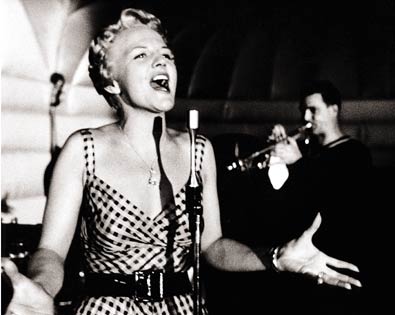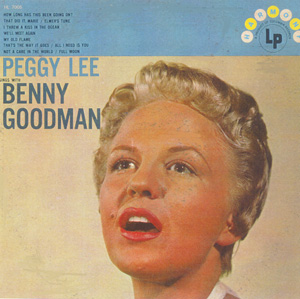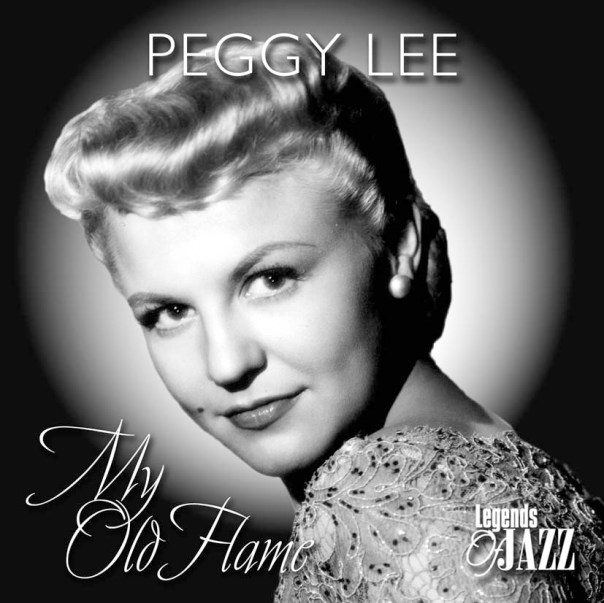Peggy Lee Peggy Lee (May 26, 1920 – January 21, 2002) was an American jazz and popular music singer, songwriter, composer and actress, in a career spanning six decades. From her beginning as a vocalist on local radio to singing with Benny Goodman’s big band, she forged a sophisticated persona, evolving into a multi-faceted artist and performer. She wrote music for films, acted, and created conceptual record albums—encompassing poetry, jazz, chamber pop, and art songs.
Lee was born Norma Deloris Egstrom in Jamestown, North Dakota, the seventh of eight children of Marvin Olof Egstrom, a station agent for the Midland Continental Railroad, and his wife Selma Amelia (Anderson) Egstrom. She and her family were Lutherans. Her father was Swedish American and her mother was Norwegian American. Her mother died when Lee was just four years old. Afterward, her father married Min Schaumber, who treated her with great cruelty while her alcoholic father did little to stop it. As a result, she developed her musical talent and took several part-time jobs so that she could be away from home.
Lee first sang professionally over KOVC radio in Valley City, North Dakota. She later had her own series on a radio show sponsored by a local restaurant that paid her a salary in food. Both during and after her high school years, Lee sang for small sums on local radio stations. Radio personality Ken Kennedy, of WDAY in Fargo, North Dakota (the most widely heard station in North Dakota), changed her name to Peggy Lee. Miss Lee moved to Los Angeles at the age of 17.
She returned to North Dakota for a tonsillectomy, and was noticed by hotel owner Frank Beringin while working at the Doll House in Palm Springs, California. It was here that she developed her trademark sultry purr – having decided to compete with the noisy crowd with subtlety rather than volume. Beringin offered her a gig at The Buttery Room, a nightclub in the Ambassador Hotel East in Chicago. There, she was noticed by bandleader Benny Goodman. According to Lee, “Benny’s then-fiancée, Lady Alice Duckworth, came into The Buttery, and she was very impressed. So the next evening she brought Benny in, because they were looking for a replacement for Helen Forrest. And although I didn’t know, I was it. He was looking at me strangely, I thought, but it was just his preoccupied way of looking. I thought that he didn’t like me at first, but it just was that he was preoccupied with what he was hearing.” She joined his band in 1941 and stayed for two years.
In 1942 Lee had her first No. 1 hit, “Somebody Else Is Taking My Place”, followed by 1943’s “Why Don’t You Do Right?” (Originally sung by Lil Green). It sold over a million copies and made her famous. She sang with Goodman’s orchestra in two 1943 films, Stage Door Canteen and The Powers Girl.
In March 1943 Lee married Dave Barbour, a guitarist in Goodman’s band. Peggy said, “David joined Benny’s band and there was a ruling that no one should fraternize with the girl singer. But I fell in love with David the first time I heard him play, and so I married him. Benny then fired David, so I quit, too. Benny and I made up, although David didn’t play with him anymore. Benny stuck to his rule. I think that’s not too bad a rule, but you can’t help falling in love with somebody.”
When Lee and Barbour left the band, the idea was that he would work in the studios and she would keep house and raise their daughter, Nicki. But she drifted back to songwriting and occasional recording sessions for the fledgling Capitol Records in 1947, for whom she produced a long string of hits, many of them with lyrics and music by Lee and Barbour, including “I Don’t Know Enough About You” (1946) and “It’s a Good Day” (1947). With the release of the US No. 1-selling record of 1948, “Mañana,” her “retirement” was over. In 1948 Lee joined Perry Como and Jo Stafford as a rotating host of the NBC Radio musical program The Chesterfield Supper Club. She was also a regular on NBC’s Jimmy Durante Show and appeared frequently on Bing Crosby’s radio shows throughout the late 1940s and early 1950s.
She left Capitol for Decca Records in 1952, but returned to Capitol in 1957. She is most famous for her cover version of the Little Willie John hit “Fever” written by Eddie Cooley and John Davenport, to which she added her own, un-copyrighted lyrics (“Romeo loved Juliet,” “Captain Smith and Pocahontas”) and her rendition of Leiber and Stoller’s “Is That All There Is?”. Her relationship with the Capitol label spanned almost three decades, aside from her brief but artistically rich detour (1952–1956) at Decca Records, where in 1953 she recorded one of her most acclaimed albums, Black Coffee. While recording for Decca, Lee had hit singles with the songs Lover and Mister Wonderful.
In her 60-year-long career, Peggy was the recipient of three Grammy Awards (including the Lifetime Achievement Award), an Academy Award nomination, The American Society of Composers, Authors and Publishers (ASCAP) Award, the President’s Award, the Ella Award for Lifetime Achievement, and the Living Legacy Award from the Women’s International Center. In 1999 Lee was inducted into the Songwriters Hall of Fame.
Lee was a successful songwriter, with songs from the Disney movie Lady and the Tramp, for which she also supplied the singing and speaking voices of four characters. Her collaborators included Laurindo Almeida, Harold Arlen, Sonny Burke, Cy Coleman, Duke Ellington, Dave Grusin, Quincy Jones, Francis Lai, Jack Marshall, Johnny Mandel, Marian McPartland, Willard Robison, Lalo Schifrin and Victor Young. She wrote the lyrics for popular songs that include, “It’s A Good Day,” “The Heart Is A Lonely Hunter,” “Mañana (Is Soon Enough for Me),” and “The Shining Sea.” Her first published song was in 1941, “Little Fool.” “What More Can a Woman Do?” was recorded by Sarah Vaughan with Dizzy Gillespie and Charlie Parker. “Mañana (Is Soon Enough for Me)” was No.1 for 9 weeks on the Billboard singles chart in 1948, from the week of March 13 to May 8.
Lee was a mainstay of Capitol Records when rock and roll came onto the American music scene. She was among the first of the “old guard” to recognize this new genre, as seen by her recording music from The Beatles, Randy Newman, Carole King, James Taylor, and other up-and-coming songwriters. From 1957 until her final disc for the company in 1972, she produced a steady stream of two or three albums per year that usually included standards (often arranged quite differently from the original), her own compositions, and material from young artists.
In 1952 Lee starred opposite Danny Thomas in The Jazz Singer (1952), a Technicolor remake of the early Al Jolson part-talkie film The Jazz Singer (1927 film). In 1955, she played an alcoholic blues singer in Pete Kelly’s Blues (1955 film), for which she received an Academy Award nomination for Best Supporting Actress. In 1955 Lee did the speaking and singing voices for several characters in Disney’s Lady and the Tramp. In 1957, Lee guest starred on the short-lived ABC variety program, The Guy Mitchell Show.
Lee continued to perform into the 1990s, sometimes in a wheelchair. After years of poor health, she died of complications from diabetes and a heart attack at age 81. She was buried in Westwood Village Memorial Park Cemetery in Los Angeles’ Westwood, Los Angeles, California neighborhood. On her marker in a garden setting is inscribed, “Music is my life’s breath.”




